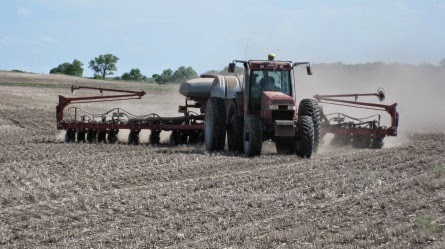On-Farm Research: Seeing is Believing
by Sandra Wick, Agriculture & Natural Resources Agent
WOW…..what a rain we received pretty much all around our district! It was just nice to watch it rain. There were some reports of hail, but hopefully damage is fairly minimal to our crops.
K-State’s Research and Extension’s mission is to provide the citizens of Kansas with technical information and education that can enhance the economic viability and quality of life in our communities. One good way to do this is through well-planned and carefully-conducted demonstrations or “on-farm research” that serves as one of the most effective Extension education tools ever developed. Although complete demonstrations require considerable time and effort, the payback comes when producers readily adapt practices they perceive to be appropriate under local conditions. This is known as “seeing is believing.” Clients who observe demonstrations of the latest techniques or practices and then apply them to their own particular situations are our present and future Extension leaders. Demonstrations should illustrate the application of appropriate technology, that is, technology that fits the local set of conditions. When this occurs, the maximum learning will result from the resources invested.
The need for demonstrations was first recognized over a century ago by Seaman A. Knapp, an Extension pioneer. Knapp’s theory was that farmers would not change their methods as a result of observing farms operated at public expense, but that demonstrations conducted by farmers themselves on their own farms under ordinary farm conditions were the answer. In Knapp’s words, “What a man hears, he may doubt; what he sees, he may also doubt; but what he does, he cannot doubt.” In 1903, Knapp proved his point through now famous demonstrations or on-farm research. The demonstration included a small farm in Texas that planted half in corn and half in cotton. The purpose was to illustrate the effects of using different seed varieties, fertilizers, methods of planting, and cultivation. The farmer made $700 more than might have been expected and the demonstration was a success. Then the opportunity came to use demonstrations on a broad scale in the weevil-infested areas of Texas and two adjoining states. Knapp demonstrated improved cotton growing methods. With a $40,000 budget, he directed more than 20 federal agents who worked with some 7,000 farmers to establish demonstration plots. This marked the beginning of demonstrations in the Cooperative Extension Service.
Post Rock Extension District is very fortunate to have many producers who are willing to put in the extra time and effort for on-farm research or demonstration test plots. We recently held the annual Wheat Demonstration Test plot tours with 5 wheat demonstration plots in four counties. Thanks to Jaime Reneberg, Steve Kuhlman, Russ Mann, Calvin Bohnert and Marty Fletchall as cooperators of the “on-farm wheat research" for K-State Research and Extension and for the Post Rock District!
For this spring, we also have some “on-farm research” with Brent Harzman with a soybean plot along with Tom Deneke with a grain sorghum replicated demonstration plot and Wyatt Rhoades with a grain sorghum plant population field study.
 | |
| Rhoades putting in the grain sorghum population field study |
“Knowledge for Life” continues to be our goal for K-State Research and Extension, so our educational programming provides research-based information from the university to the producers of our district.








